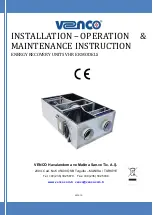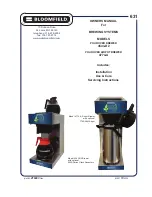
5
ENGLISH
• Risk of electric shock: An electric shock
coming from the welder electrode may cause death.
Do not weld when raining or snowing. Do not touch the electrode
with bare hands. Do not wear wet or damaged gloves. Personal
protection against electric shock: insulate from the work piece. Do
not open the equipment enclosure.
• Arc generated risks: Arc radiation may
burn your eyes and damage the skin. Wear helmet and
protection goggles. Use ear protection. Wear protection clothes to
protect the skin up to your neck. Always use full body protection.
• Risk induced by electro-magnetic fields:
When welding, the current produces electro-magnetic fields.
Do not use the power source if having medical implants. Never
roll soldering cables around the waist. Join and set parallel the two
soldering cables so that the fields will counteract in each other.
• Do not use the welder power source to de-ice
pipes.
• Never allow unexperienced people disassemble
or regulate the welder.
• Double check that both the operator and the
welder are out of the reach of sparks and residue originated by
the welding process.
• To operate the welder, it shall be set in a place protected from
sun or rain. Away from places where violent vibration is present.
• Store the welder in a place with no humidity with a temperature
range of -13 °F to +131 °F
• Environment temperature range: When
welding: 14 ºF, up to + 104 º
• There shall be a 20” free space around the welder to assure
good ventilation.
• The base of the welding power source must be
inclined at a maximum of 10º to avoid overturning.
• Double check there is no foreign metal object
inside the welder.
• If there are issues with the welder the
operator cannot solve making the adjustments needed for a good
welding job shall be solved in a Authorized
Service Center. For no reason at all try to open the welder carcass
to carry out any type of maintenance.
• Wear welding helmet to protect your
eyes and face when working with the welder. Double check
the shadow lens of the welding helmet is right for the welding
process to carry out.
• Use welders’ hide gloves. Also hide
breastplate and leggings.
• Wear sturdy clothes and long sleeves made of flame resistant
materials like wool or leather.
• Use special screens or curtains to insulate the work place and
protect passersby from sparks, glare and slag originated in the
welding process.
• Benches and work tables where the work pieces’ rest shall have
orifices or slots that let pass easily residues originated by the
soldering process.
Protection Equipment for Welding
• Verify there is a safe connection of the input
and output cables. The cables hall be correctly insulated and the
connections in good repair (check and eliminate any possibility
of short circuit).
• Double check the welder has a trusted ground
connection.
• Do not expose the welder to rain or humidity
conditions.
• Keep yourself insulated from the work piece
and ground stepping dry insulated mats.
• For no reason at all touch the two poles in the
welder circuit (stick and work piece).
• Do not try to adjust the welder voltage when
soldering.
• Connect the ground clamp to the work piece as
close as possible to the welding zone to prevent the current flow
through long distances, thus eliminating the possibility of short
circuit.
To Prevent Electric Shock
• Always have handy a fire extinguisher
in good working conditions.
• There shall not be flammable or explosive
materials in the work area (not closer than 36 feets). Do not carry
out welding jobs in places where sparks may reach or fall onto
flammable or explosive materials.
Do not weld drums or any other closed container.
• Welding sparks may cause explosions
or fire.
To Prevent Fire
CAUTION
WARNING
CAUTION
CAUTION
CAUTION
CAUTION
CAUTION
DANGER
WARNING
WARNING
WARNING
WARNING
WARNING
WARNING
WARNING
WARNING
WARNING
• Vapors and gases produced while doing
welding jobs are dangerous to your health. Work in well
ventilated places or with adequate ventilation systems.
• Do not breath smoke or gas come out from
the welding process. Keep your head away from the fumes.
• If ventilation is poor use an adequate
autonomous breathing device. The protection gases generated
during the welding job may displace air and cause fatal accidents.
• Do not operate the welder close to degreasing
substances, cleaner or spray cans. Heat and radiation in the
welding process may react with the vapors and create toxic gases.
• Avoid welding metals covered with lead, zinc or
cadmium. These materials generate toxic gases. Otherwise,
remove the covering from the welding are. double check the area
is well ventilated or use an adequate autonomous breathing
device.
To Prevent Health Hazards
CAUTION
CAUTION
CAUTION
CAUTION
CAUTION
WARNING
WARNING
DANGER
To Prevent Injuries and Accidents
CAUTION
WARNING
Safety Warnings
for Welders
















































